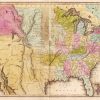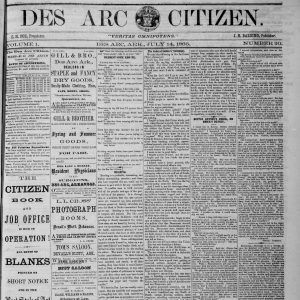calsfoundation@cals.org
Des Arc Citizen
As the first newspaper in Prairie County, the Des Arc Citizen was established in Des Arc (Prairie County) in September 1854 by John C. Morrill. Published weekly, issues were four pages long and focused on state politics, the Methodist Episcopal Church, agriculture, development projects for railroads and river levees, and news from Memphis, Tennessee. In 1861, a new twice-weekly edition, the Des Arc Semi-Weekly Citizen, was published simultaneously. The new edition was short-lived, and later that same year the newspaper returned to a singular weekly edition called the Des Arc Weekly Citizen.
In the lead up to the Civil War, the Des Arc Citizen supported leaving the Union. Disagreeing with secessionist views, Weston H. Rhea created the Constitutional Union (1860–1861) in Des Arc and served as both proprietor and editor. The Constitutional Union’s masthead stated, “The Constitution, the Union, and the Enforcement of the Laws.” This four-page weekly paper focused on state and national politics, with articles discussing international opinions on American politics. Recurring features included “Poetical” and “Telegraphic!” sections. The Constitutional Union ended after only five months.
During the Civil War, Union major general Samuel Ryan Curtis captured Des Arc, and the town was partially destroyed. The Citizen suspended publication due to the war. However, the newspaper resumed publication in 1866 with Elijah H. Poe and James H. Balding as proprietors and N. B. Gair as editor. In its first issue, on February 20, 1866, the newspaper encouraged the rebuilding of Des Arc and praised the previous six months of progress. The newspaper stated, “Many of her old citizens, scattered to the four winds of heaven by the fortunes or misfortunes of the war, are returning to Des Arc, bankrupt as to means, but willing, and anxious to contribute their mite [sic] in rebuilding this once pleasant and lovely town.”
In June 1866, the partnership between Poe and Balding was dissolved, and Poe served as sole proprietor until January 1867, when he partnered with Allen C. Mathews. Balding continued as publisher until the end of 1866. In February 1867, the newspaper’s name was changed to the Des Arc Weekly Citizen. According to Fred Allsop’s History of the Arkansas Press for a Hundred Years and More, Balding sold the paper in 1867 to A. C. Matthews, who continued its publication until 1897. However, the paper was purchased by James J. Baugh in 1885, and he moved the operations to Searcy (White County), where it became the Daily Citizen.
Beginning in 2017, the Arkansas Digital Newspaper Project (ADNP) team at the Arkansas State Archives partnered with the Library of Congress as part of the National Digital Newspaper Program (NDNP), funded by grants from the National Endowment for the Humanities (NEH), to digitize historic Arkansas newspapers, including the various iterations of the Des Arc Citizen.
For additional information:
Allsopp, Frederick W. History of the Arkansas Press for a Hundred Years and More. Little Rock: Parke-Harper Publishing Co., 1922.
Biographical and Historical Memoirs of Eastern Arkansas. Chicago: Goodspeed Publishing Co., 1890.
“Des Arc Citizen.” Chronicling America. Library of Congress. https://chroniclingamerica.loc.gov/lccn/sn89051343/ (accessed March 18, 2025).
“Des Arc Weekly Citizen.” Chronicling America. Library of Congress. https://chroniclingamerica.loc.gov/lccn/sn89051342/ (accessed March 18, 2025).
“Des Arc Semi-Weekly Citizen.” Chronicling America. Library of Congress. https://chroniclingamerica.loc.gov/lccn/sn89051341/ (accessed March 18, 2025).
“Des Arc Citizen.” Chronicling America. Library of Congress. https://chroniclingamerica.loc.gov/lccn/sn89051370/ (accessed March 18, 2025).
“Des Arc Weekly Citizen.” Chronicling America. Library of Congress. https://chroniclingamerica.loc.gov/lccn/sn84027696/ (accessed March 18, 2025).
Staff of the Arkansas Digital Newspaper Project
Arkansas State Archives
A version of this entry was initially published on both the website of the Arkansas State Archives and the Library of Congress’s Chronicling America project and is used here with permission.
 Louisiana Purchase through Early Statehood, 1803 through 1860
Louisiana Purchase through Early Statehood, 1803 through 1860 Mass Media
Mass Media Des Arc Citizen
Des Arc Citizen 



Comments
No comments on this entry yet.